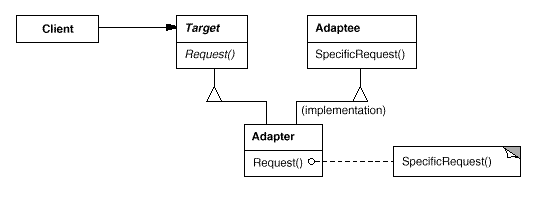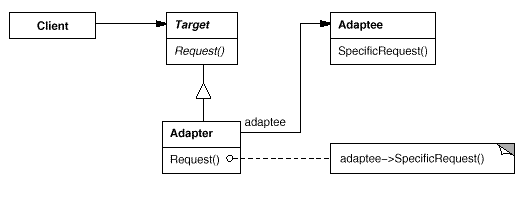- Aka: Wrapper
- Intent: Convert the interface of a class into another interface clients expect. It lets classes work together that couldn’t otherwise because of incompatible interfaces.
Structure
Variations
-
Class Adapter - Use of polymorphic interfaces which define the contracts that an adapter must adapt by. The adapter then inherits from these interfaces.

Image from: Gamma, Helm, Johnson, and Vissides -
Object Adapter - the adapter maintains an instance of the class it is wrapping (like a Decorator).

Image from: Gamma, Helm, Johnson, and Vissides
Applicability
- You want to use an existing class, and its interface does not match the one you need.
- You want to create a reusable class that cooperates with unrelated or unforeseen classes, that is classes don’t necessarily have compatible interfaces.
- (Object adapter) You need to use several existing subclasses, but it’s impractical to adapt their interface by subclassing every one. An adapter can adapt the interface of its parent class.
Consequences
Class adapter
- Adapts adaptee to target by committing to a concrete abstract class. Hence it won’t work for adapting subclasses.
- Lets adapter override some of adaptee’s behavior
- Introduces only one object and no pointer indirection is needed to get the adaptee
Object adapter
- Lets a single Adapter work with many Adaptees
- Makes it harder to override adaptee behavior.
In general:
- Adapters can adapt many adaptees
- Interface adapters let us incorporate our class into systems that expect different interfaces to the class.
- Two way adapters provide transparency from the target to the adaptee and back.
Implementation
Use pluggable adapters
Find the smallest subset of operations that let us do the adaptation (narrow interface). Then use any of the following:
- Define abstract operations for the narrow adaptee interface.
- Use delegate objects to forward requests
- Parameterize the adapters